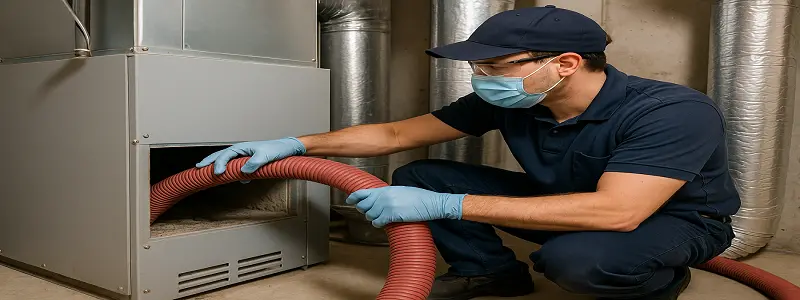We use cookies to personalise site content, social media features and to analyse our traffic. We also share information about your use of this site with our advertising and social media partners.
Posted by - Airduct Cleaning -
on - Sep 22 -
Filed in - Other -
commercial HVAC duct cleaning -
284 Views - 0 Comments - 0 Likes - 0 Reviews

Commercial buildings rely on efficient HVAC systems to maintain indoor air quality and regulate temperature. Over time, ducts accumulate dust, debris, allergens, and even microbial growth that can compromise air circulation and system performance. To ensure clean air delivery and compliance with health and safety regulations, many facility managers look to established industry standards for guidance on best practices in Commercial Air Duct Cleaning.
Commercial HVAC duct cleaning matters because it directly impacts air quality, energy efficiency, and occupant health. Dirty ductwork can harbor allergens, bacteria, and dust that circulate through vents into offices, warehouses, and other work environments. According to the National Air Duct Cleaners Association (NADCA), proper cleaning can improve airflow, reduce strain on heating and cooling systems, and lower operational costs. A well-maintained system can also prevent unnecessary repairs to the furnace, AC, and other components.
Unclean ductwork can lead to several issues including restricted airflow, uneven heating and cooling, and higher utility bills. Excessive buildup can force HVAC units to work harder, shortening their lifespan. In some cases, microbial growth can cause odors or lead to indoor air quality complaints. Dust near vents, frequent filter changes, or unexplained allergy symptoms among employees can be signs it’s time to schedule professional HVAC duct cleaning services.
Following recognized industry standards ensures consistency, safety, and quality results. Certified companies typically use advanced tools like negative air machines, rotary brushes, and HEPA-filtered vacuums to perform deep cleaning of ducts, vents, and air handlers. As HVAC specialist Johnathan Meyers notes,
“A standardized approach to duct cleaning is not just good practice, it’s essential for maintaining healthy, efficient building operations.”
Adhering to standards helps prevent damage to ductwork, maintains compliance with building codes, and gives peace of mind that the work meets best practices. It can also support warranties on HVAC systems since manufacturers often recommend periodic cleanings.
Professional commercial HVAC duct cleaning involves a detailed process that includes inspection, containment of dust, mechanical agitation, and vacuum collection. Key features of a high-quality service include use of NADCA-certified technicians, comprehensive cleaning of supply and return ducts, and optional sanitization treatments to address bacteria or mold. Some companies also offer furnace, and chimney cleaning as part of bundled packages to provide a full indoor air care solution.
The air duct cleaning cost for commercial buildings depends on factors like building size, number of vents, accessibility of ductwork, and level of contamination. Industrial facilities Duct Cleaning Services and multi-story offices may require specialized equipment and additional labor, increasing the overall price.
| Building Type | Average Cost | Notes |
|---|---|---|
| Small Office (Under 10,000 sq. ft.) | $450 - $1,000 | Includes supply/return ducts and basic sanitization |
| Medium Commercial Space (10,000–25,000 sq. ft.) | $1,000 - $3,500 | May include multiple HVAC units |
| Large Industrial Facility | $3,500+ | Requires custom quote due to complexity |
Disclaimer: Prices vary by location, company, and job specifications. Always request a detailed estimate from local cleaners before scheduling. Searching “air duct cleaning near me” can help compare multiple providers and specials to find the best professional service for your area.
Are there official standards?
Yes. NADCA’s ACR Standard is widely recognized in the industry. It outlines procedures for inspection, cleaning, and restoration of HVAC systems.
How often should ducts be cleaned?
Most experts recommend every 3–5 years, though facilities with high dust loads, industrial equipment, or heavy foot traffic may require more frequent cleanings.
Does duct cleaning improve HVAC performance?
Yes. Cleaner ducts allow for better airflow, reducing stress on the system and helping maintain consistent temperature control.
Can it reduce energy costs?
According to the U.S. Department of Energy, proper HVAC maintenance can improve efficiency by up to 25%, leading to lower utility bills over time.
Is commercial air duct cleaning different from residential?
Yes. Commercial systems are often larger, more complex, and require specialized equipment and experienced technicians.
Industry standards play a vital role in ensuring commercial ductwork is properly inspected, cleaned, and maintained. By following guidelines like those from NADCA, facility managers can protect indoor air quality, reduce energy consumption, and extend the life of HVAC equipment. When comparing companies, look for certified cleaners, transparent pricing, and a proven track record. Whether you manage a small office, an industrial plant, or a multi-story commercial building, adhering to best practices in commercial HVAC duct cleaning is an investment in long-term system reliability and occupant well-being.
Read More: Commercial HVAC Duct Cleaning

“To assist disaster survivors by providing a source for them to come together in time of need, to aid in the listing of events, information and other forms of assistance, and continuing support through the recovery process.”
Share this page with your family and friends.